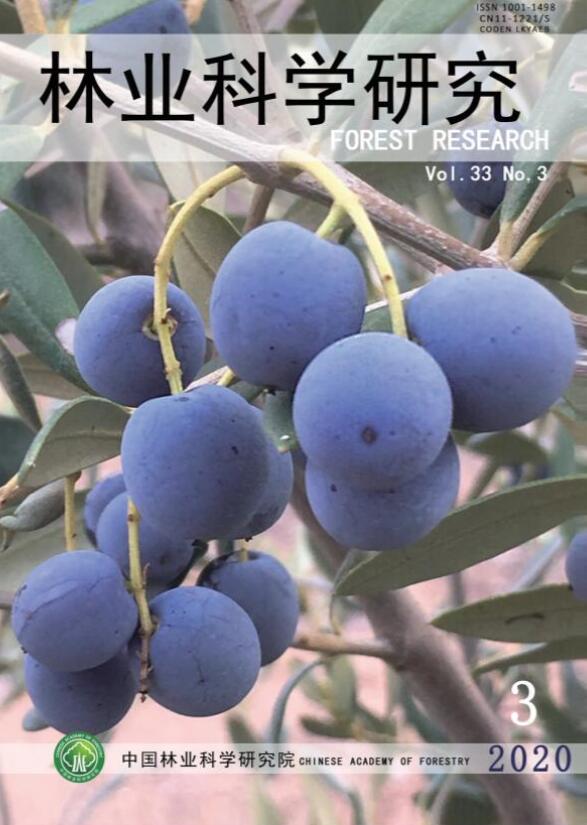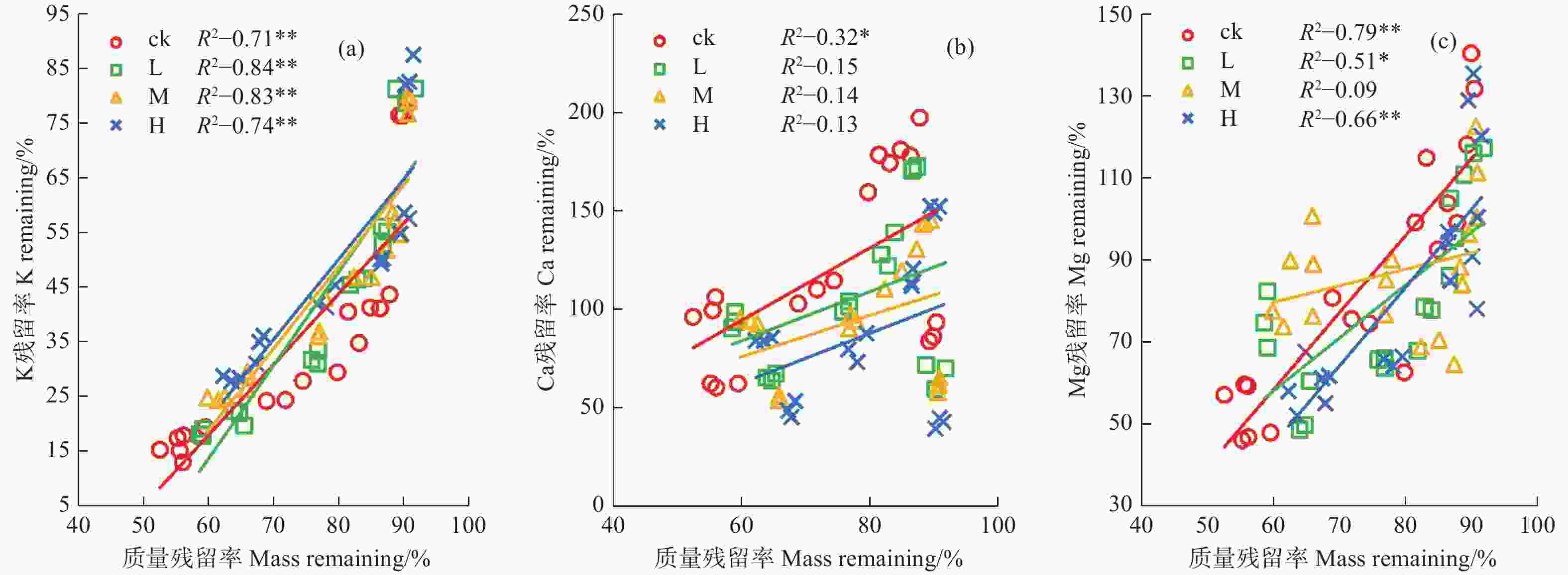-
凋落叶分解过程中的元素释放不仅有助于植物的生长发育[1],还是改良森林生态系统结构功能的关键过程[2]。研究氮沉降对凋落物分解过程中元素释放的影响,对于了解森林生态系统养分动态和元素循环对氮沉降的响应具有重要意义。现有的研究更加关注氮沉降对凋落叶分解过程中Ca、N、P元素释放的影响,其影响机制也比较明确。研究表明,氮沉降通过改变凋落叶及环境中的N含量,造成凋落叶分解过程中养分元素的不平衡,影响分解者对养分的需求,以及改变酶活性等方式影响Ca、N、P元素的释放[3-5]。而氮沉降对凋落物分解过程中K、Ca、Mg元素释放影响的研究还相对缺乏,且不同区域间的研究结果还存在较大差异。如,Munasinghe等[6]研究表明,氮沉降抑制了美国弗吉尼亚州阔叶混交林凋落叶中Ca元素的释放;而李仁洪等[7]的研究表明氮沉降促进了华西雨屏区慈竹凋落叶分解过程中K、Ca、Mg元素的释放;张林等[8]研究发现,氮沉降对亚热带常绿阔叶甜槠林中凋落叶K、Ca、Mg元素无显著影响。
华西雨屏区主要森林植被类型为常绿阔叶林,受邛崃山脉和岷江山脉的影响,该区域大气氮沉降以湿沉降为主[9-10],2008—2010年年均氮湿沉降量为9.5 g·m−2[11],远高于同期中国50个森林站点观测的氮沉降年平均值1.66 g·m−2[12],这一特性为研究氮沉降对常绿阔叶林凋落物分解过程中K、Ca、Mg元素释放的影响提供了天然实验室。前期研究表明,氮沉降抑制了华西雨屏区天然常绿阔叶林凋落叶的分解[13],抑制了分解过程中Ca、N元素的释放,促进了P元素的释放[14],但氮沉降对该区域凋落叶分解过程中K、Ca、Mg元素释放的影响还不清楚。基于此,本研究以华西雨屏区天然常绿阔叶林为研究对象,研究了模拟氮沉降对凋落叶分解过程中K、Ca、Mg元素浓度和残留率的影响,旨在了解模拟氮沉降对凋落叶分解过程中K、Ca、Mg元素浓度、释放模式以及释放速率有何影响?为全面揭示该区域常绿阔叶林在氮沉降持续增加背景下养分元素的循环过程提供参考。
-
研究区位于四川省雅安市雨城区碧峰峡风景区(102°59ʹ E,30°03ʹ N),气候类型为亚热带季风型气候,最高气温25 ℃,最低气温6 ℃,年均气温16 ℃,年平均降水量1 770 mm,年蒸发量1 010 mm。区域大气氮沉降以湿沉降为主[9],2008—2010年氮湿沉降量约为9.5 g·m−2·a−1[11]。研究区内植被丰富,乔木层植物以海桐(Pittosporum tobira Thunb.)、硬斗石栎(Lithocarpus hancei Benth.)、木荷(Schima superba Gardn.)、润楠(Machilus pingii Cheng ex Yang.)和青榨槭(Acer davidii Frarich.)等为主。试验地位于中坡,坡度较小,土壤类型为黄壤。
-
2013年10月在研究区选择具有代表性的天然常绿阔叶林,在该林分中随机设置12个3 m×3 m的小样方,每个样方间设置3 m的缓冲带。在阔叶林中收集主要树种(木荷、硬斗石栎和海桐)的新鲜凋落叶,将其充分均匀混合带回实验室自然风干,然后把风干的凋落叶在烘箱中于65 ℃下烘干至恒质量,计算出水分转化系数,接着测定凋落叶的初始质量及养分元素浓度(表1)。称取20.0 g风干后的凋落叶,装入准备好的尼龙网分解袋中。尼龙网分解袋大小为20 cm×20 cm,贴地面层孔径为0.05 mm,表面层孔径为1.00 mm。2013年11月,去除样方内土壤表面的凋落物,将准备好的凋落物分解袋随机均匀地放置在12个样方土壤表面。在每个样方中放置18个凋落袋(1年×6次×3个重复),12个样方共计放置216个凋落袋。
碳C 氮N 磷P 钾K 钙Ca 镁Mg 430.73±8.71 8.32±1.14 0.42±0.04 13.25±0.24 2.45±0.06 1.36±0.07 Table 1. Initial nutrient elements concentration of litter in rainy area of western China
g·kg−1 本试验氮沉降水平参考2008—2010年研究区氮湿沉降量(9.5 g·m−2·a−1)[11],设置对照、增加50%、150%和300%4个水平,即为对照(0 g·m−2·a−1, CK)、低氮(5 g·m−2·a−1, L)、中氮(15 g·m−2·a−1, M)和高氮沉降(30 g·m−2·a−1, H),每个氮沉降水平设置3个重复。大气湿氮沉降中的氮元素主要形式是NH4+和NO3−[12],因此以NH4NO3作为氮源,从2013年11月中旬起,每隔半个月进行人工模拟氮沉降。具体方法是:将每次每个样方所需的NH4NO3溶解在2 L清水中,在样方内均匀喷洒,对照样方中施等量清水。
-
从2013年11月中旬起,每2个月收集一次凋落物分解袋,每次随机从每个样方中采集凋落袋3袋。将凋落袋迅速带回室内,先将袋外泥土去除,在烘箱中于65 ℃下烘干至恒质量后,称量凋落叶并计算其质量损失率[13],然后将凋落叶粉碎,再利用原子吸收分光光度计法测定K、Ca、Mg元素浓度及其残留率。
-
质量损失率=(M0-Mt)/M0×100%
式中:Mt为凋落叶在t时刻的质量,M0为凋落叶初始干质量。
养分残留率=(Ct×Mt)/(C0×M0)×100%
养分释放率=100%−(Ct×Mt)/(C0×M0)×100%
式中:Mt为该阶段凋落叶干质量,M0为凋落叶初始干质量;Ct为t时刻凋落叶养分浓度,C0为初始养分浓度。
利用Microsoft Excel 2013进行分类汇总,采用SPSS 22.0统计软件,对每次取样的凋落叶质量损失率、K、Ca、Mg浓度以及残留率进行单因素方差分析,利用重复测量方差分析检验各处理间凋落叶质量损失率、K、Ca、Mg浓度以及残留率的差异性,通过Pearson相关性分析检验各处理下凋落叶质量残留率与K、Ca、Mg元素残留率的相关关系。利用Excel 2013和SigmaPlot12.5制作相关图表。本研究所使用的凋落叶质量残留率数据为本课题组前期研究结果[13]。
-
由图1a可以看出,各处理的凋落叶K元素浓度动态变化均一致,表现为在整个分解过程中一直呈下降趋势。分解1年后,L、M和H处理的K元素浓度分别比CK高17.76%、52.52%和68.66%。重复测量方差分析表明(表2),氮沉降各处理的K元素浓度均显著高于CK(P<0.05)。这表明,氮沉降显著抑制了凋落叶分解过程中K元素浓度的降低。
处理
Treatments质量损失率
Mass loss rate/%浓度Concentration/(g·kg−1) 残留率Remaining/% K Ca Mg K Ca Mg CK 22.71±1.52a 7.04±0.27a 3.74±0.13a 1.48±0.12a 44.65±1.87a 116.81±5.36a 85.56±4.91a L 19.98±0.66b 7.84±0.18b 3.24±0.10b 1.39±0.08a 50.46±1.02b 104.55±3.51b 82.04±4.72a M 18.75±0.75c 8.36±0.28c 2.92±0.09c 1.50±0.12a 53.71±1.77c 95.99±3.00c 88.22±6.72a H 17.59±0.67d 8.77±0.23d 2.66±0.09d 1.37±0.15a 56.84±1.54d 89.33±3.11d 84.29±7.44a 注:不同小写字母表示差异达到P=0.05显著水平。
Note:Different lowercase letters indicate significant difference at P=0.05 level.Table 2. The significant of concentration and remaining of K, Ca, Mg elements and mass loss rate in various treatments
各处理的凋落叶Ca元素浓度动态变化均表现为相同趋势,在凋落叶分解的前4个月,各处理的Ca元素浓度整体呈上升趋势,4~10个月表现为下降趋势,10~12个月呈上升趋势(图1b)。分解1年后,L、M和H处理的Ca元素浓度分别比CK低12.98%、16.37%和27.43%。重复测量方差分析表明(表2),氮沉降各处理的Ca元素浓度显著低于CK(P<0.05)。这表明,模拟氮沉降显著促进了凋落叶分解过程中Ca元素浓度的降低。
CK、L和H处理的凋落叶Mg元素浓度动态变化均一致,表现为在分解前2个月呈增加趋势,2~10个月呈下降趋势,10~12个月呈增加趋势;M处理的凋落叶Mg元素浓度表现为分解前2个月呈增加趋势,2~6个月呈下降趋势,6~12个月呈增加趋势(图1c)。分解1年后,L和M处理的Mg元素浓度分别比CK高15.86%和18.08%,H处理的Mg元素浓度比CK低15.08%。重复测量方差分析表明(表2),氮沉降各处理的Mg元素浓度与CK之间差异均不显著(P>0.05)。这表明,模拟氮沉降对凋落叶分解过程中Mg元素浓度无显著影响。
-
由图2a可以看出,各处理凋落叶K元素释放率均随着分解时间的延长而增加,表明凋落叶分解过程中K元素的释放表现为直接释放模式。分解1年后,L、M和H处理的K元素残留率分别比CK高3.91%、10.27%和13.91%。重复测量方差分析表明(表2),氮沉降各处理的K元素残留率显著高于CK(P<0.05)。这说明,氮沉降显著抑制了凋落叶分解过程中K元素的释放。
各处理凋落叶Ca元素释放动态整体一致,Ca元素在分解前2个月表现为释放状态,之后的2~12个月由富集变为释放状态(图2b),凋落叶分解过程中Ca元素释放表现为释放-富集的交替模式。分解1年后,L、M和H处理的Ca元素残留率分别比CK低6.39%、6.51%和15.93%。重复测量方差分析表明(表2),氮沉降各处理的Ca元素残留率显著低于CK(P<0.05)。这说明,模拟氮沉降显著促进了凋落叶分解过程中Ca元素的释放。
各处理凋落叶Mg元素释放动态均一致,在分解前2个月呈富集状态,随后均表现为释放状态(图2c),凋落叶分解过程中Mg元素的释放表现为富集-释放模式。分解1年后,L、M和H处理的Mg元素残留率分别比CK高16.31%、21.44%和0.58%。重复测量方差分析表明(表2),氮沉降各处理与CK之间无显著差异。这说明,模拟氮沉降对凋落叶分解过程中Mg元素的释放无显著影响。
-
将凋落叶质量残留率与K、Ca、Mg元素残留率进行相关性分析。从图3a中可以看出,各处理凋落叶质量残留率与K元素残留率均呈极显著的正相关,表明氮沉降没有改变凋落叶质量残留率与K元素残留率的正相关关系;CK处理的凋落叶质量残留率与Ca元素残留率呈显著的正相关,而L、M和H处理凋落叶质量残留率与Ca元素残留率的相关性不显著(图3b),说明氮沉降降低了凋落叶质量残留率与Ca元素残留率的正相关关系;CK、L和H处理的凋落叶质量残留率与Mg元素残留率呈显著的正相关,M处理凋落叶质量残留率与Mg元素残留率的相关性不显著(图3c),表明L和H处理并未改变凋落叶质量残留率与Mg元素残留率的正相关关系,M处理降低了两者的正相关关系。
-
K作为非结构性元素,主要溶解在植物细胞中,是凋落叶中较易淋失的养分元素[15]。本研究结果表明,各处理的凋落叶K元素浓度在分解过程中一直呈降低趋势,也印证了这一观点。本研究还发现,模拟氮沉降显著抑制了凋落叶分解过程中K元素浓度的下降。这与Liu等[16]和赵晶等[17]的研究结果一致。其原因可能有以下两点,一是铵离子(NH4+)与钾离子(K+)半径几乎相同,氮沉降增加了凋落叶中NH4+浓度[18],从而影响了K+的浓度,导致K元素浓度升高[18];二是由于氮沉降增加了凋落叶N元素浓度,为了维持凋落叶中的元素计量平衡,K元素浓度也会相应增加[19]。但陈秋凤[20]在福建杉木人工林的研究表明,氮添加降低了凋落物分解过程中K元素的浓度。出现差异的原因可能是,一方面陈秋凤研究区域属于氮限制区[20],而本区域是氮富集区,添加外源氮,会打破N/K的平衡,森林生态系统为了维持N/K的平衡,微生物可能会从外界吸收K元素,从而抑制了K元素浓度的下降;另一方面可能与两者使用的氮源不同有关,本试验以NH4NO3为氮源,而陈秋凤以CO(NH2)2为氮源。施用CO(NH2)2相当于同时添加C和N两种元素,C元素含量改变会在很大程度上影响凋落叶的分解[21],进而改变其分解过程中K元素的含量。
本研究结果表明,模拟氮沉降显著促进了凋落叶分解过程中Ca元素浓度的下降。这与刘文飞等[22]的研究结果相似。其原因可能是氮沉降增加了凋落叶中的氮,使得多余的氮以硝酸根离子(NO3−)的形式从凋落叶中淋失,为了调节凋落叶中的电荷平衡,钙离子(Ca2+)也随之淋失,从而造成钙元素浓度降低[23]。但赵晶等[17]研究发现,施氮处理增加了樟树凋落枝分解过程中Ca元素的浓度。出现差异的原因可能与研究区域背景氮沉降量有关。本试验区域氮沉降水平为9.5 g·m−2·a−1[12],远高于赵晶等[17]研究区域的氮沉降水平2.9 g·m−2·a−1。在缺氮的区域,氮素要先满足生态系统的氮需求,只有在富氮的环境中,才会有多余的NO3−从凋落叶中淋失进而导致Ca元素浓度的减少[23]。
模拟氮沉降对凋落叶分解过程中Mg元素浓度无显著影响。这与赵琼等[24]的研究结果一致。可能是Mg并非结构性物质,相较于氮沉降,其浓度变化更容易受到生物和物理因素的影响[25]。Osono等[26]也认为,凋落叶分解过程中Mg元素浓度主要受水分运动的影响,其次取决于微生物的活动。
-
在各处理中,凋落叶分解过程中的K元素均表现为净释放模式,Ca元素呈释放-富集的交替模式,Mg元素呈富集-释放模式,模拟氮沉降并未改变凋落叶分解过程中K、Ca、Mg元素的释放模式。这是因为凋落叶的初始质量决定了其分解过程中养分的释放模式[27-29]。初始浓度高的元素在凋落叶分解过程中常表现为释放模式,初始浓度低的元素常从环境中固定养分[27-28]。在本试验凋落叶中,K元素初始浓度为13.25 g·kg−1,远高于Ca(2.45 g·kg−1)和Mg元素(1.36 g·kg−1)的初始浓度(表1)。K元素呈净释放模式主要由于降雨的淋溶作用;对于Ca和Mg元素而言,其释放更多地取决于微生物的分解而不是淋溶作用[30],Ca和Mg元素初始浓度相对较低,不能满足微生物的生长和繁殖需求,会向周围环境中获取养分,从而造成了凋落叶分解过程中Ca和Mg元素的富集[27-28]。
-
本研究发现,氮沉降显著抑制了凋落叶分解过程中K元素的释放。这与宋学贵等[31]的研究结果一致。这是因为K作为凋落叶的主要营养元素,其释放速度主要取决于凋落叶的分解速率,凋落叶分解速率加快会促进K元素的释放,反之则会抑制其释放[32]。本研究中,K元素残留率与凋落叶质量残留率呈极显著的正相关关系(图3a),也印证了这一观点。前期研究表明,模拟氮沉降抑制了凋落叶的分解[13],从而导致K元素的释放也受到抑制。
本研究结果表明,模拟氮沉降显著促进了凋落叶分解过程中Ca元素的释放。这与涂利华等[33]和李仁洪等[7]的研究结果一致。其原因可能是本研究区的氮沉降水平相对较高,模拟氮沉降加速了酸性环境的形成[34],这将提高Ca元素在凋落叶中的溶解性和流动性[35],从而加速Ca元素的释放。另外一种观点认为,真菌能够将Ca元素固定成为草酸钙晶体从而抑制其释放[36]。前期的研究结果表明,模拟氮沉降降低了真菌数量[37],真菌数量的降低减弱了其对Ca元素的固定作用,导致Ca元素的释放速率加快。本研究还发现,模拟氮沉降降低了凋落叶质量残留率与Ca元素残留率的正相关关系(图3b),其原因是模拟氮沉降抑制了凋落叶的分解[13],但同时又促进了Ca元素释放,进而减弱了凋落叶质量残留率与Ca元素残留率的正相关关系。
本研究结果表明,模拟氮沉降对凋落叶分解过程中Mg元素的释放没有显著影响。Wang等[38]在加拿大北部针阔混交林开展的研究也得到了相同的结果。原因可能是,与氮沉降相比,Mg元素的释放更加受到环境因素(如温度和降水量等)的影响[23]。但也有学者指出,凋落叶分解过程中Mg元素的释放对环境变化不太敏感[39]。氮沉降对凋落叶分解过程中Mg元素释放的影响机制还存在争议,仍需进一步研究。
-
经过1年的分解试验,模拟氮沉降对凋落叶分解过程中K、Ca、Mg元素浓度的影响不一致,表现为模拟氮沉降显著抑制了凋落叶分解过程中K元素浓度的下降,显著促进了Ca元素浓度的下降,对Mg元素浓度无显著影响;模拟氮沉降并未改变K、Ca、Mg元素的释放模式,在凋落叶分解过程中,对照与各处理的K元素呈净释放模式,Ca元素表现为释放-富集的交替模式,Mg元素呈富集-释放模式;模拟氮沉降对K、Ca、Mg元素释放速率的影响不一致,表现为模拟氮沉降显著抑制了凋落叶分解过程中K元素的释放,显著促进了Ca元素的释放,对Mg元素释放无显著影响。本研究结果可为研究氮沉降背景下凋落叶分解过程中K、Ca、Mg元素的循环过程提供一定的参考。但由于大气氮沉降的长期性和复杂性,在氮沉降持续增加的背景下,氮沉降对凋落物分解过程中K、Ca、Mg元素释放的影响仍需进行长期的研究。
Effects of Simulated Nitrogen Deposition on the Releases of Potassium, Calcium, and Magnesium During Litter Decomposition in a Natural Evergreen Broadleaved Forest in the Rainy Area of Western China
- Received Date: 2019-09-18
- Accepted Date: 2020-01-20
- Available Online: 2020-05-01
Abstract:









 DownLoad:
DownLoad:

